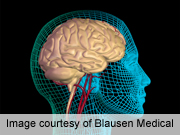
FRIDAY, April 13 (HealthDay News) — The physical architecture of intelligence in the brain has been mapped by scientists who used brain injury patients to conduct their research.
The findings provide new insight about the specific brain structures involved in general intelligence and specific skills such as memory and the ability to understand words.
The study included 182 Vietnam War veterans who had highly localized brain damage caused by penetrating head wounds.
“It’s a significant challenge to find patients [for research] who have brain damage, and even further, it’s very hard to find patients who have focal brain damage,” study leader Aron Barbey, a professor of neuroscience at the University of Illinois, said in a university news release.
Many people who’ve suffered brain damage from stroke or other causes have multiple impaired brain areas. This makes it difficult to identify the specific functions of individual brain structures.
Studying people with highly localized brain damage enables researchers “to draw inferences about how specific brain structures are necessary for performance,” Barbey said.
“By studying how damage to particular brain regions produces specific forms of cognitive [thinking] impairment, we can map the architecture of the mind, identifying brain structures that are critically important for specific intellectual abilities,” he explained.
The participants in this study underwent CT scans and a number of tests of their intellectual abilities. The researchers found that “several brain regions, and the connections between them, were most important for general intelligence.”
The locations of these structures were mainly behind the forehead (within the left prefrontal cortex), behind the ear (left temporal cortex) and at the top rear of the head (left parietal cortex). The investigators also found significant overlap between brain regions that handle executive functions, such as planning and self-control, and those vital to general intelligence.
The findings offer new evidence that intelligence does not rely on just one brain region or the brain as a whole, but rather specific brain areas that work together in coordination, Barbey said.
The study was released online in advance of publication in an upcoming print issue of Brain: A Journal of Neurology.
More information
Harvard Medical School’s Whole Brain Atlas has more about the brain.

